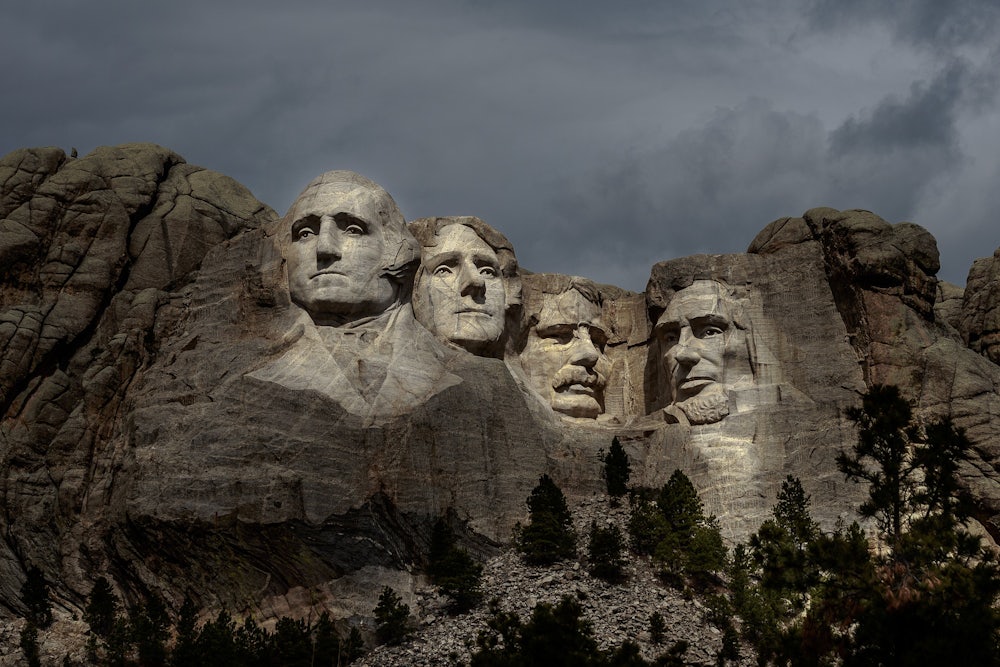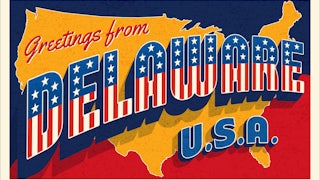South Dakota is in the news because a consortium of journalists exposed shady doings there that take advantage of the state’s status as a notorious tax haven, and because the state’s governor, Kristi Noem, is caught up in an outrageous nepotism scandal and in general has been working overtime to wrestle the mantle of nation’s worst governor away from Ron DeSantis.
Say what you will about DeSantis, though, you won’t hear many people argue that Florida shouldn’t exist. South Dakota is another story.
The great state of South Dakota was stolen in 1743 by the French in the person of Louis-Joseph Gaultier de La Vérendrye. La Vérendrye—who very grandly called himself Le Chevalier—was a fur trapper and explorer acting on behalf of his father, Pierre, commandant of New France. (Nepotism is a South Dakota tradition.) The precise Native American tribe from whom South Dakota was stolen is not certain, but Le Chevalier called them the Gens de la Petite-Cerise or “People of the Little Cherry,” and probably they were the Arikara, a Plains Indians tribe that had broken off from the Pawnee.
This is the rare instance in human history in which the theft of somebody’s little cherry was commemorated on a chiseled plaque. That was a hunk of lead dug up in 1913 and known today as the Verendrye Plate. Bearing the inscription of King Louis XV, the plate had been engraved in Latin by Le Chevalier’s père (who, incidentally, is not the same Pierre after whom South Dakota’s capital city is named). Le Chevalier scattered similar lead plates along his journey, chortling in his journal about one of these that “the savages … did not know of the tablet of lead that I had placed in the earth.”
South Dakota remained in French hands until 1803, when Napoleon Bonaparte, feeling overextended by the obligations of empire, included it in the parcel of 828,000 square miles that he sold to President Thomas Jefferson. Nobody paid much attention to these northern reaches of the Louisiana Purchase, still largely under Native American control, until plans got underway in the 1850s to lay railroad tracks across the Great Plains. The result was the creation of the Dakota Territory and, for the Dakota tribe (or eastern Sioux), the usual combination of displacement, duplicitous treaties, and revolt. The white man, as usual, slaughtered his Native American adversary into submission.
In 1889 the territory was admitted to the union, as part of a historic push that would also grant statehood to Washington, Idaho, Montana, and Wyoming. This was, according to the historian Heather Cox Richardson, a deliberate effort by the Republicans, newly in control of the White House—Benjamin Harrison having beaten incumbent Grover Cleveland the year before—to expand their power base after their Gilded Age “swing toward Big Business” had lost them popular support elsewhere. Creating two Dakotas made little practical sense. “There is no such territory as South Dakota,” a Minnesota newspaper observed. “South Dakota is a mythical political organization and for all practical purposes may as well be called the territory of Timbuctoo.” But splitting the territory in two gave the GOP six new political bases instead of five.
“What’s particularly remarkable about this turn of events,” The Washington Post’s Philip Bump observed in March,
is that it remains responsible for the Republican Party holding half of the seats in the Senate. Of those 12 seats added during that stretch from 1889 to 1890, Republicans still hold nine seats—a six-seat advantage for the party.
So there’s that to hold against South Dakota (and North Dakota, too—two states with a combined population of fewer than two million that get four senators). Meanwhile, not quite a century after South Dakota was admitted to the union, amid the economic slump of the late 1970s, this imposter of a state began its transformation into a paradise for tax evaders, kleptocrats, and other wealthy lowlifes.
It began with a phone call from Citibank to the state’s longest-serving governor, William “Wild Bill” Janklow. Inflation was raging, interest rates were sky-high, and credit card companies were hemmed in by anti-usury laws in all 50 states. A 1978 Supreme Court decision offered a way out by permitting a credit card company located in a state with very high interest rates to charge the same rate to customers in other states.
If Janklow would abolish South Dakota’s interest-rate ceiling, Citibank promised, Citibank would create 400 jobs in his state. In 1981, Janklow delivered. “Thanks to Janklow,” Oliver Bullough wrote in The Guardian in 2019, “South Dakota has a financial services industry, and the US has a trillion-dollar credit card debt.”
Delaware and Nevada followed South Dakota’s lead, creating a financial services boom in those states, too, and prompting Janklow to wonder how he could keep ahead of the other regulatory bottom-feeders. The answer was a see-no-evil approach to individual and family wealth. Already South Dakota had no income tax, no capital gains tax, and no estate tax. Why not make the state even more hospitable to the wealthy by repealing something called “the rule against perpetuities” and rendering family trusts immortal?
A trust is a financial arrangement, dating to medieval times, in which property is conferred for safekeeping to a third party, or trustee, on behalf of one’s heirs, or beneficiaries. In modern times, the calamity from which the trust is typically kept safe is taxation. Until fairly recently, though, the length of time this wealth could be protected was limited by mortality through the rule against perpetuities.
The rule against perpetuities, which is rooted in eighteenth-century English common law, said that 21 years after the death of the youngest beneficiary, a trust must be liquidated and the wealth contained therein subjected once again to the capital gains tax, the estate tax, and any other taxes that lie within a particular jurisdiction. Later, states amended that to limit a trust’s lifetime to 90 years. The rule was intended to check dynastic power and to restrict the power of the dead over the living.
In 1957, Idaho decided to repeal the rule against perpetuities. In 1969, Wisconsin followed suit. In South Dakota, Janklow wanted family wealth to live forever, too, so in 1983 he persuaded the state legislature to repeal the rule. Then the dam burst, with Delaware, Alaska, and a dozen other states falling in line. So Janklow created a “trust taskforce” to stay ahead of the competition. Among its innovations was a mechanism allowing you to establish a trust in which the beneficiary was … yourself.
According to Chuck Collins’s 2021 book, The Wealth Hoarders, a trust attorney named Pierce McDowell alerted the world to South Dakota’s wealth-hiding potential in a 1993 article for Trust and Estates magazine. Citibank’s trust and estate planning office promptly hired McDowell to charter a trust company in South Dakota. McDowell later left Citibank to create the South Dakota Trust Corporation. Today, according to The Washington Post’s Debbie Cenziper, Will Fitzgibbon, and Salwan Georges, the South Dakota Trust Corporation “boasts a roster of international clients from 54 countries.” Their money will never die.
South Dakota became a world capital of patrimonial capitalism, with “dynasty trusts” protecting the family wealth of the Pritzkers (Hyatt), the Carlsons (Radisson), and the Wrigleys (chewing gum), among others, according to Collins.
Legal tax avoidance wasn’t the only questionable activity enabled by government coddling of the wealthy, according to the Post, the Guardian, and other members of the consortium that produced the new Pandora Papers series. South Dakota’s lax financial regulations are also, according to the series, fantastic enablers of illegal or brazenly immoral activity unrelated to tax-dodging. A company called Trident Trust, the Post reported, hid from prying eyes
a Colombian textile magnate caught in a scheme to launder the proceeds of an international drug ring, an orange juice mogul who settled with authorities in Brazil for allegedly colluding to underpay local farmers, and family members of the former president of a sugar producer in the Dominican Republic that has been accused of exploiting laborers and forcibly evicting families from their homes.
“The U.S.,” Collins writes, “is the new Switzerland.” Switzerland lost its hard-won status as the world capital for stashing loot a decade ago, after Swiss multinational investment bank UBS had to pay out nearly $1 billion for enabling tax evasion by U.S. citizens. Germany, France, Italy, and Belgium made similar recoveries, and in 2010 Congress passed the Foreign Accounts Tax Compliance Act to require greater transparency from Americans who hide money in foreign banks. Then, in 2014, the G-20 and the Organization for Economic Cooperation and Development created the Common Reporting Standard, which required countries to share more banking information. And there the United States drew the line. It wouldn’t sign. It wouldn’t sign because the U.S. had become the new Switzerland, or Grand Cayman, or isle of Jersey—an international haven for hiding wealth.
With South Dakota in the lead.
We’ve put up with this moral sewage long enough. Let’s abolish South Dakota by merging it into North Dakota. If Congress has the power under the admissions clause to admit new states, shouldn’t it also have the power to dissolve them? Everybody makes mistakes! As Jonathan Chait argued some years back in TNR about Delaware, the Mount Rushmore state long ago forfeited through bad behavior any claim on our allegiance or respect. Unlike Delaware, South Dakota was never supposed to exist in the first place. Le Chevalier should have stayed in France and left the northern Great Plains’s little cherry alone. Now the place is just 77,000 square miles of undead family fortunes.










